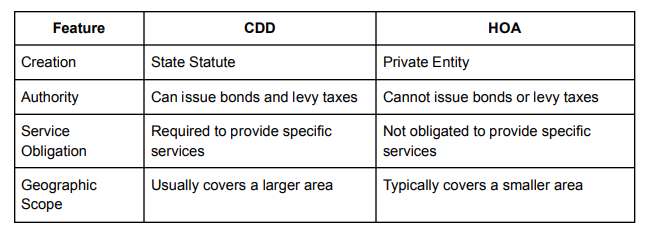Hey there, future Kissimmee homeowner! I’m Jury Hernandez, your local real estate expert, and today I want to take the mystery out of two things that often make buyers pause: CDDs and HOAs. You’ve probably seen these acronyms pop up while browsing homes here in Florida, but don’t worry—they’re not as complicated as they sound.
Let’s break it down in simple, real-world terms so you can feel confident navigating your home-buying journey.
Understanding the Basics: What are CDDs and HOAs?
In a nutshell, both Community Development Districts (CDDs) and Homeowners Associations (HOAs) are set up to manage and maintain aspects of a community. But here’s where they
Differ:
- CDDs are like mini-governments created by the state of Florida. They handle the big stuff—building roads, parks, and other infrastructure—by using funds collected through property taxes.
- HOAs, on the other hand, are private organizations set up by developers. They focus on the daily upkeep of common areas and making sure your neighborhood looks its best. Think landscaping, community pools, and enforcing rules like keeping your lawn in check.
Deciphering CDDs: Infrastructure and Fees
Picture this: You move into a sparkling new community with beautifully paved streets, parks, and a resort-style pool. Sounds amazing, right? That’s all thanks to the CDD. But keeping everything running smoothly comes with costs.
Here’s how it works:
- Bonds: CDDs issue bonds to finance infrastructure. These are paid back over time through property taxes.
- Assessments: These fees cover maintenance, like keeping the landscaping pristine and the streetlights glowing.
- Taxes: Yes, CDDs can levy taxes to fund ongoing operations.
If this sounds like a lot, don’t worry—it’s all part of building a strong, sustainable community.
Adding Pros and Cons of CDDs
Now, let’s talk about the ups and downs of living in a CDD-governed community.
Pros:
- You’ll enjoy top-notch amenities, well-maintained infrastructure, and parks that are Instagram-worthy.
- Communities with CDDs often see higher property values thanks to their appeal.
- Your neighborhood will be designed for long-term sustainability.
Cons:
- The fees can add up, and they’re tied to your property taxes.
- Even if you don’t use all the amenities, you’re still required to contribute.
- CDD bonds can mean financial obligations for years to come.
It’s all about weighing what’s most important to you!
Navigating HOAs: Rules, Responsibilities, and More Fees
HOAs are all about keeping your community cohesive and beautiful. Think of them as the guardians of your neighborhood’s vibe—ensuring everyone follows the same rules for landscaping, paint colors, and even parking.
Here’s a quick breakdown:
- Membership: Joining the HOA is mandatory for most communities.
- Fees: These vary depending on the neighborhood but can cover everything from pool maintenance to security.
- Coverage:
○ Single-Family Homes: You’re usually responsible for your roof and exterior maintenance.
○ Townhomes: The HOA often covers roof and exterior upkeep for shared walls.
○ Condominiums: Most condo HOAs handle all exterior maintenance, which can make life simpler
Including HOA Due Diligence Tips and Manager Engagement Advice
If you’re considering a home in an HOA-governed community, there are a few steps you’ll want to take to ensure you’re fully informed:
1. Review the Documents: Take the time to go through the HOA’s covenants, bylaws, and rules. These documents will outline what’s covered and what you’ll be responsible for.
For example, are you allowed to park a boat in your driveway? Can you paint your front door a funky color? Now’s the time to find out.
2. Engage with the HOA Manager: Don’t hesitate to call up the HOA manager. Ask about:
○ Insurance coverage and reserve funds.
○ Any upcoming fee increases.
○ Maintenance schedules and what’s planned for the future.
These conversations can give you invaluable insights into how the HOA is managed and whether it aligns with your expectations.
CDD vs. HOA: Spotting the Differences
I know, it can get confusing keeping these two entities straight! here’s a quick cheat sheet:

Beyond CDDs and HOAs: CFDs in Kissimmee
Just when you thought you had it all figured out, there’s another acronym: CFDs (Community Facilities Districts). They’re less common but worth mentioning. CFDs come into play when local governments take on responsibilities like community improvements and maintenance.
In Kissimmee, there are four CFD communities:
- Crescent Lakes
- Indian Creek
- Indian Point
- Indian Ridge Villas
Before You Sign on the Dotted Line: Essential Tips for Buyers
Here’s how to navigate CDDs, HOAs, and CFDs like a pro:
- Do Your Research: Check if the home is in a CDD or HOA, and get clear on what the fees cover.
- Ask Questions: Reach out to the HOA manager or CDD representative to understand what’s included, how fees are calculated, and if there are any big changes on the horizon.
- Review the Documents: Don’t skip this step during the inspection period. Knowing the rules and restrictions upfront will save you headaches down the line.
Ready to Find Your Dream Home in Kissimmee?
Buying a home is a big step, but understanding how CDDs and HOAs work can make all the difference. And remember—you don’t have to do it alone. I’m here to guide you every step of the way.
If you’re ready to start your search or just have more questions, let’s chat! Book a free consultation, and together, we’ll find the perfect community for you and your family. Let’s make your dream home a reality!















